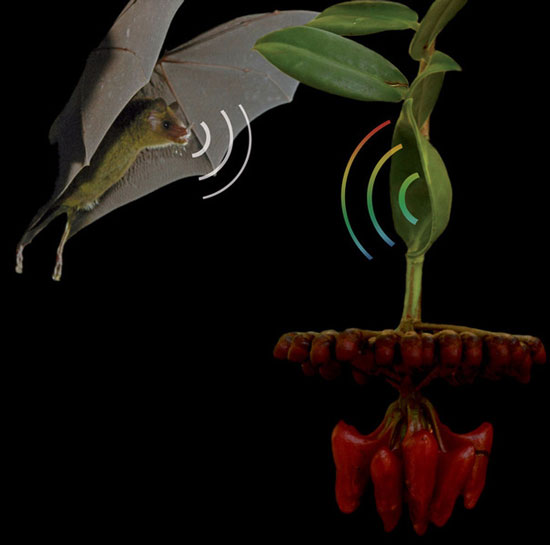Plants also have pan antennas
Scientists have discovered the plant Marcgaravia evenia - a Cuban plant pollinated by bats that have evolved with a special leaf that acts as a pan antenna to collect ultrasound that bats transmit.
This is the first time such a feature has been discovered in plants. Normally, plants rely solely on colorful colors to attract pollinators. However, there are hundreds of species of plants pollinated by bats, and researchers are still investigating how bats find " need " plants.
In the laboratory, scientists found that long- billed Pallas bats are good at detecting hollow hemispherical shapes hidden between artificial leaves.

Marcgravia evenia plants have leaves that act as pan antennas ( photo: NatGeo ).
Next, Ralph Simon of the University of Ulm, Germany noticed special leaves above the flower of Marcgravia evenia and thought that such hemispherical leaves must be a signal to bats.
To test this statement, scientists conducted the experiment and as a result, the bats discovered the flower (where the bat makes food) 50% faster when the flower comes with a special leaf of M. .evenia. Conversely, if the flower comes with a regular leaf, the search time will decrease by 6%.
The researchers also investigated the intensity and direction of the simulated ultrasound reflected from M.evenia leaves. The results showed that echoes from the leaves bounced off in all directions and were easily captured by the yearly bat.
M.evenia is a rare plant and distributed unevenly in nature, so attracting bats at a distance is important for its survival.
Another Central South American plant is M.holtonii , which has the ability to signal bats with a specialized counterpart inside its flower. However, scientists found a step further in M.evenia, "a real echo of the lighthouse, " Holdereid said.
- Molecular signals from insect antennas
- The antenna is 'wearable'
- Radio antennas made from Plasma
- Liberate the mobile phone network
- Mitsubishi researches making antennas from seawater
- The project turns trees into multi-purpose biological sensors
- Trees also behave like people
- 80,000 species of plants on Earth are about to become extinct
- How is 'that' in plants?
- There is no brain but plants are smarter than we think
- Extremely hidden carnivorous plants
- 'Discover healthy indoor plants
 Why do potatoes have eyes?
Why do potatoes have eyes? 'Tragedy' the world's largest carnivorous life: Death becomes ... public toilet
'Tragedy' the world's largest carnivorous life: Death becomes ... public toilet Tomatoes were once considered 'poisonous' for 200 years
Tomatoes were once considered 'poisonous' for 200 years Detecting microscopic parasites on human face
Detecting microscopic parasites on human face